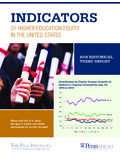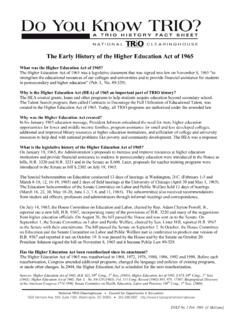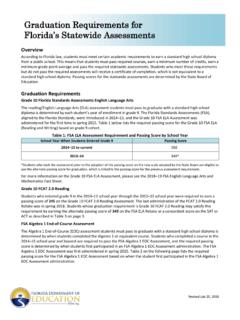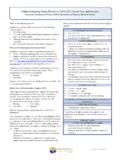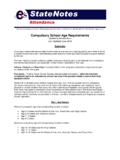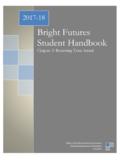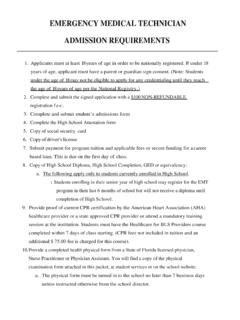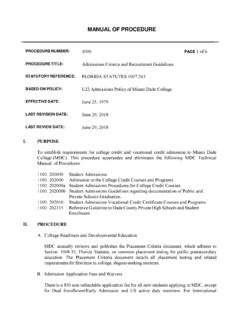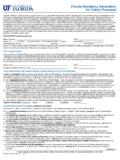Transcription of National Studies Find TRIO Programs - Pell Institute
1 National Studies find TRIO Programs Effective at Increasing College Enrollment and GraduationSince 1997, four National Studies conducted by the Department of Education have been completed on the Federal TRIO Programs . Data from these Studies demonstrate that participation in a TRIO program has a significant impact on the educational outcomes of low-income, first-generation students and students with Support ServicesIn 1997, Westat, Inc. completed and submitted an assessment report1 to the Department of Education on the impact of Student Support Services (SSS). The report s findings suggest that SSS has a statistically significant positive effect on student success, persistence, and retention. These findings conclusively indicate that SSS is an effective program. When compared to similarly qualified students, who did not participate in the program, SSS participants were more likely to:1. Remain enrolled in higher education, 2. Accrue more college credits, and3. Earn higher grade point averages (GPAs).
2 The study also found that the size of program impact was directly and positively related to the level of program participation. Stated otherwise, the effects of the program were found to be more profound as students individual participation increased. In addition, the effect of SSS on outcomes was determined to be related to specific services received peer tutoring in the first year showed the greatest positive study utilized a quasi-experimental design and regression analyses to assess the impact of Student Support Services. A total of 5,800 students at 47 postsecondary institutions were tracked over the course of a three year period. A comparison group of 2,900 students was constructed to match the demographic and educational profiles of 2,900 first-year student SSS participants who enrolled during the 1991 92 academic year. Subsequent follow-up Studies championing the effectiveness of SSS have been completed; however, these reports were not released by the George W. Bush Administration and have yet to be DescriptionStudent Support Services Programs provide tutoring, counseling, and remedial instruction to low-income, first-generation college students and students with disabilities.
3 These Programs enable students to successfully begin their college careers, persist in their Studies , and, ultimately, earn bachelor s degrees. Currently, there are more than 945 Programs serving nearly 200,000 students Chaney, B., Muraskin, L., Cahalan, M., & Rak, R. (1997). National study of Student Sup-port Services: Third-year longitudinal study of results and program implementation study update. Washington, DC: Department of Data presented throughout this brief are a percent change in the mean, performance rate, or participation rate of students in the treatment group relative to students in the control Detailed Findings 2 Retention Compared to similarly qualified students in the control group, SSS students were:12% more likely to be retained to the second year (67% vs. 60%), and23% more likely to be retained to the third year (49% vs. 40%).Credits Earned Compared to similarly qualified students in the control group, SSS students earned:6% more credits in the first year, 4% more credits in the second year, and4% more credits in the third year.
4 GPA Compared to similarly qualified students in the control group, SSS students GPAs were:7% higher in the first year, 5% higher in the second year, and 4% higher over three years (cumulative).Talent SearchIn 2006, Mathematica Policy Research, Inc. (MPR) completed and submitted an assessment report3 to the Department of Education on the impact of Talent Search on secondary and postsecondary outcomes in Texas, Indiana, and Florida. When compared to similarly qualified students, who did not participate in the program, statistically significant findings revealed that, across all states, Talent Search participants were more likely to:1. Apply for financial assistance, and2. Enroll in postsecondary impact is particularly notable because the cost per student for Talent Search is less than $ study utilized a quasi-experimental design and regression analyses to assess the effectiveness of Talent Search projects in Texas, Indiana, and Florida. These states were specifically chosen for inclusion in the study because administrative educational data systems allowed for student follow-up and the selection of appropriate control groups.
5 Data from 60% of Talent Search projects in these states were used in the study. Talent Search data merged with federal financial aid and state data to assess the impact of Talent Search participation on select outcomes. Program DescriptionTalent Search is a college access program that serves low-income youth in grades six through twelve. In addition to counseling, participants receive information about college admission requirements, scholarships, and various student financial aid Programs . Talent Search also provides low-income students and their families with assistance in choosing a college, applying for college, and applying for financial aid. This early intervention program helps young people better understand their educational opportunities and options. More than 360,000 students are enrolled in 466 Programs across the Constantine, J. M, Seftor, N. S., Martin, E. S., Silva, T., & Myers, D. (2006). A study of the effect of the Talent Search program on secondary and postsecondary outcomes in Florida, Indiana, and Texas: Final report from phase II of the National evaluation.
6 Washington, DC: Department of Detailed Findings by StateTexas Compared to similarly qualified students in the control group, Talent Search students were:12% more likely to attain a high school diploma (86% vs. 77%),77% more likely to be first time financial aid applicants (62% vs. 35%), and52% more likely to enroll full-time in a Texas public college (38% vs. 25%).Indiana Compared to similarly qualified students in the control group, Talent Search students were:31% more likely to be a first time financial aid applicant (59% vs. 45%), and8% more likely to enroll in an Indiana public college (56% vs. 52%). Florida Compared to similarly qualified students in the control group, Talent Search students were:20% more likely to attain a high school diploma (84% vs. 70%),58% more likely to be first time applicants for financial aid (52% vs. 33%), and42% more likely to immediately enroll in a Florida public college (51% vs. 36%).Variations among states could be due to differences in state and privately funded college access services available Detailed FindingsCompared to control group participants, Upward Bound students were:50% more likely to attain a bachelor s degree ( vs.)
7 ,19% more likely to attain any postsecondary degree or credential ( vs. ), and22% more likely to apply for student financial aid ( vs. ).Upward BoundIn 2009, Mathematica Policy Research, Inc. (MPR) released and submitted an assessment report4 to the Department of Education on the impact of Upward Bound on postsecondary outcomes. Dr. Margaret Cahalan, the Project Officer for the Department of Education that oversaw the technical competence of the MPR report, conducted a follow-up analysis5 of the same data and found fatal methodological flaws in the original MPR study. Dr. Cahalan s re-analysis determined Upward Bound had statistically significant and substantive positive effects on three key outcomes. Specifically, the findings revealed that when compared to an equally qualified comparison group, Upward Bound participants were more likely to:1. Complete a college degree,2. Enroll in college, and3. Apply for student financial aid. MethodsThe National Evaluation of Upward Bound (UB) is a nationally-representative random assignment study that followed a multi-grade cohort from 1992 93 to 2003 04 to evaluate the impact of Upward Bound.
8 About 1,500 students nationwide were randomly assigned to the treatment group and about 1,300 students who were not selected for Upward Bound were assigned to the control group. These students were from 67 of the 395 projects that had been operating for three years by October Seftor, N. S., Mamun, A., Schirm, A. (2009). The impacts of regular Upward Bound on postsecondary outcomes 7-9 years after scheduled high school graduation . Princeton, NJ: Mathematica Policy Research, Cahalan, M. (in press). Do the conclusions change? The case of Upward Bound, correcting for study error in the 1992-2004 National evaluation of Upward Bound. Washington, DC: The Pell Institute for the Study of Opportunity in Higher Education (publication will be posted on The Pell Institute s website ).Technical Issues in MPR Study DesignThe major technical issues in the MPR study were: (1) extreme unequal weighting, (2) treatment-control group non-equivalency, (3) survey non-response bias, (4) lack of standardization for expected high school graduation year, and (5) service submission and dropout issues.
9 To correct these issues, Dr. Cahalan s study used a complete longitudinal file, included administrator record data to correct for survey non-response bias, standardized expected high school graduation dates in deriving the outcome variables, conducted sensitivity analysis of weighting and outlier issues, and additional quasi-experimental Upward Bound ProgramUpward Bound is an early intervention program that helps low-income and potential first-generation college students prepare for higher education. Upward Bound projects bring high school students to college campuses after school, on the weekends, and during the summer to receive instruction in mathematics, laboratory sciences, composition, literature, and foreign languages. Tutoring, counseling, mentoring, cultural enrichment, and work-study Programs are additional components to the Upward Bound program. Currently, there are 964 Programs serving more than 65,000 students across the Bound Math-ScienceIn 2008, Mathematica Policy Research, Inc.
10 (MPR) released and submitted an assessment report6 to the Department of Education on the impact of Upward Bound Math-Science on postsecondary completion, performance, enrollment, and participation in math and science coursework both at the high school and postsecondary level. The study found that Upward Bound Math-Science had statistically significant and substantive positive effects on five outcomes. Specifically, the findings revealed that when compared to equally qualified students in the comparison group, Upward Bound Math-Science participants were more likely to:1. Complete a four-year degree in math or science,2. Enroll in selective four-year institutions,3. Major in math or science disciplines,4. Take chemistry and physics coursework in high school, and 5. Improve grades in math and Olsen, R., Seftor, N., Silva, T., Myers, D., DesRoches, D., & Young, J. (2008). Upward Bound Math-Science: Program description and interim impacts. Princeton, NJ: Mathematica Policy Research, Detailed FindingsCompared to similarly qualified students in the control group, UBMS students were:Twice as likely to attain a BA in math and science (12% vs.)




